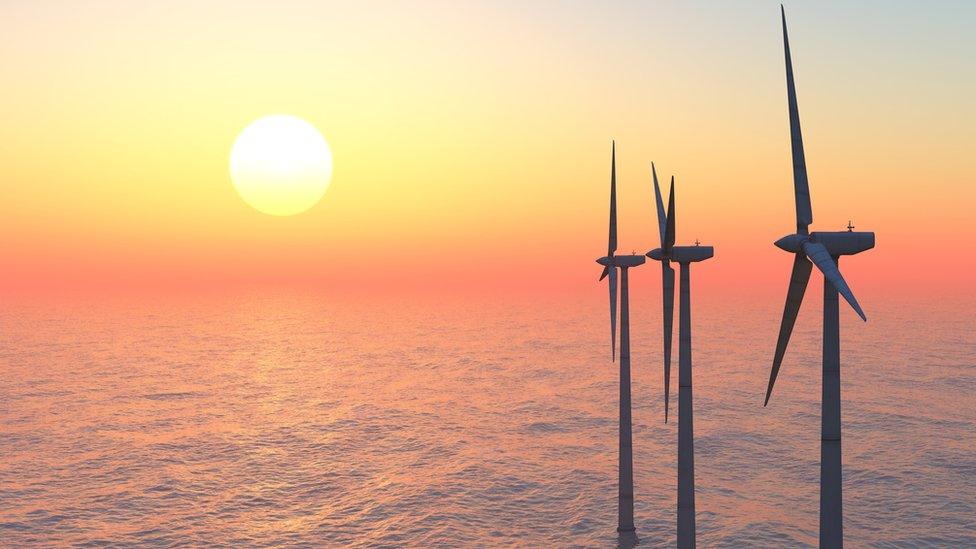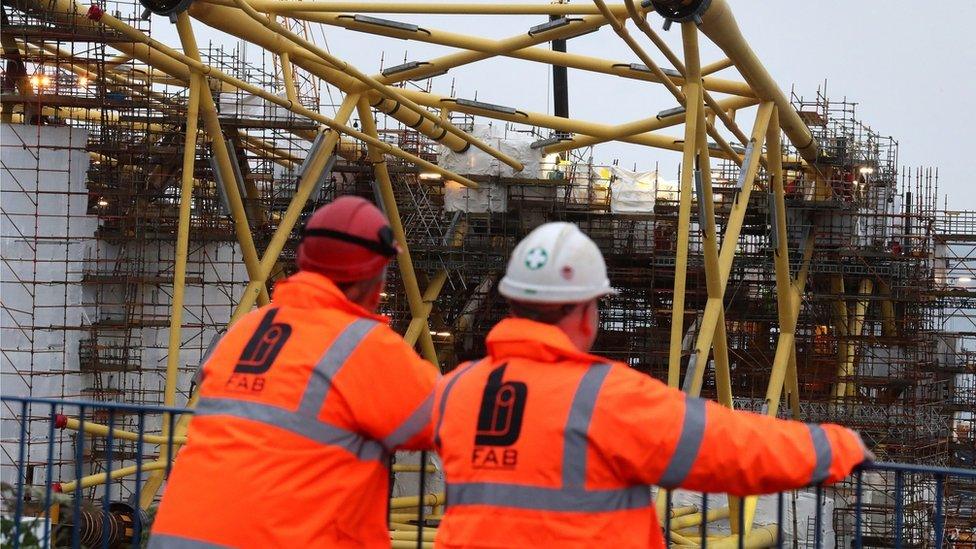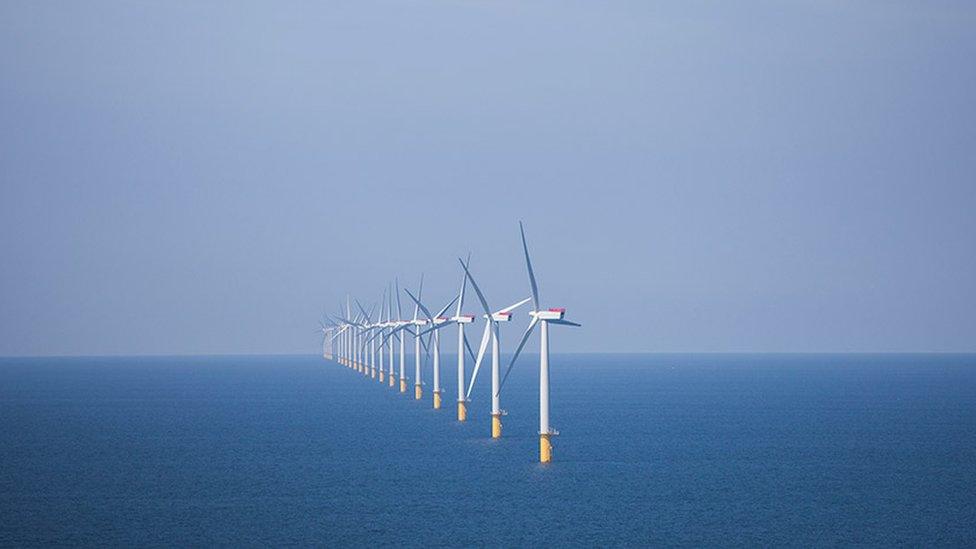Offshore wind offshored
- Published

Scotland has the resource to be a major player in renewable marine power, but it's struggling to win the manufacturing contracts.
A summit is being summoned to examine where its disadvantages lie against foreign bidders.
Those winning the work include loss-making national corporate champions, with easy access to financial guarantees.
Hopes pinned on blade production in Dundee and Renfrew: no more. Gamesa, Vestas, Areva and Doosan no more.
No sunshine on Leith for Pelamis wave power. Longannet was a sure thing for a billion pounds-worth of carbon capture funding, but that money went up in smoke - a prize pot pauchled by the Treasury.
Siemens chose Hull. Samsung spurned Methil. Areva departed: its memorandum of understanding must have been a misunderstanding.
Gamesa linked with Siemens and stayed in Spain. Doosan reversed out of turbine design. And wave power went bust.
In the past 10 years, I've seen all these hopes rise, and I've reported on them crumbling to not very much.
So excuse me for some scepticism when I hear from shadow Chancellor John McDonnell at the Scottish Labour conference this weekend, saying there are 50,000 jobs to be had in green energy.
That's if the energy sector is brought into public ownership, the short-termism of the market is terminated, and the workers become its managers. Maybes aye, probably naw.
Not all is lost. Orkney has its testing centre. Wave power technology is now in public hands, awaiting a better weather window.
Stornoway has just won 80 jobs to make seabed piles, allowing the Arnish fabrication yard to re-open.
Campbeltown has a factory making turbine towers. Scotland has expertise in project development. And Glasgow has office jobs monitoring wind farm performance.
But if this is "the Saudi Arabia of renewable energy", and "the re-industrialisation of Scotland" - which is what we were told it would, could or should be - it doesn't feel much like it.
Spaghetti web
There's a particularly chill wind in Fife. The BiFab yards at Methil and Burntisland have a totemic role. Big on potential to make the shift from offshore oil to offshore wind, they are mothballed, looked after by a staff of less than 20. At peak, they had 1,400.
They could be absorbing skilled welders, fitters and sparks as the aircraft carrier contracts at Rosyth are wound down. Hundreds more jobs are expected to go there before long. But trade unions tell us the latest and biggest contract, which BiFab needs has gone elsewhere.

BiFab was saved from administration following Scottish government intervention
It's time to find out why. Nicola Sturgeon is to convene "a summit", to address the concerns raised by Unite the Union, the GMB and others.
As Ms Sturgeon's government has both a political and financial stake in BiFab, this matters more than most industrial headaches.
For DF Barnes, the Canadian firm attracted into Scotland to take over the yards last April, saving BiFab from financial collapse, there's been a harsh and bewildering lesson in Europe's arcane contracting processes.
The "spaghetti web of vested interests" appears, to the trade unions, to have obscured the real reasons why offshore wind contracts are being lost.
Burach
But isn't all this a bit late to be summiteering? The scale of what is already in the North Sea is staggering. Britain is seeing investment of £18bn in the four years to 2021. It has 37 wind arrays built, comprising 2000 turbines. It has nearly 8,000 megawatts of capacity, which is comfortably more output than Scotland requires.

Many projects are focused on England's east coast
Most of that is off the east English coast, where shallower water, and cheaper grid connection charges make more financial sense, even if the wind isn't as strong as Scotland can offer.
The price of offshore wind has plummeted. Measured by the level of subsidy required as an incentive to build it out, that has more than halved in the past five years.
Another reverse auction to get companies to bid the lowest price was due this year, but doesn't look likely. It seems the government's attention has been elsewhere - if not on Brexit, then on the burach that is nuclear power policy.
Late starter
It does, however, have an appetite for more. The UK government last week set out its vision for taking wind power from meeting 8% to 30% of UK electricity demand, pledging to do a bit to build up the supply chain.
The industry happily signed up. It is expert at urging ministers to set ever more ambitious targets, in the knowledge that achieving them will require government to provide the necessary framework and subsidy.
Scotland is a late starter to this. There is one wind farm on the Solway coast, and in the outer Moray Firth, Beatrice is half-built. A handful of turbines are in a testing centre off the Aberdeen coast, most notable for having riled Donald Trump. And, er, that's it.
Scotland has been talking a big game in potential for renewable energy, while others have been getting on with it. And those others have developed supply chains which now have scale and efficiency.
That puts them at an advantage as the industry grows - and not just in the North Sea. A gathering of the industry at a global level, in Taipei last week, heard that Britain's 8 giggwatts is a large part of the worldwide 30 gigawatts. The worldwide target set was for 500 gigawatts by 2050.
Steep learning curve
The first test of the revived BiFab was to win a share of the vast Moray East wind farm. It is being built by a consortium led by Portugal's main energy firm.
Off the coast of Caithness from Wick to Lybster, it is to have 100 turbines, around 200 metres high, each rated 9.5 megawatts. (Think of it this way: only five of these turbines on top of each other would be higher than most Munro mountains.)
The contract for the blades is already lost, to a Danish company. The Danes were early into wind power. James Howden & Co Ltd in Glasgow was at the forefront in the early 1980s but lost government support and gave up on turbines by 1989. (It should be an obligatory case study for students of British industrial policy.)
For Moray East, there is a "first tier" procurement contractor called Deme, based in Belgium.
It has handed the contract for 45 of the jackets (the platforms standing on the seabed to support the turbines) to a company which will build them in the United Arab Emirates.
Lamprell has already been building for the North Sea. Having previously made jack-up rigs for shallow water oil and gas fields, typical of the Persian Gulf, it waded into the renewables market without adequate planning or expertise.
So in building 60 jackets for Scottish Power Renewables, developer of the East Anglia One wind array, it sustained a $98m loss. That only narrowly avoided breaching its funding covenants.
Its chairman reflected, with the 2017 results, that building 60 jackets on an assembly line is very different from several rigs at the same time.
There were start-up costs and inefficiencies, said Lamprell, and "the learning curve turned out to be steeper than anticipated".
Supply chain
Talking of loss-making companies, meet Navantia. It builds warships for the Spanish navy. And in tough times for the public purse, it has diversified into offshore renewables, while making very substantial losses. Last year, it was 390m euros in the red. Being state-owned, that is readily absorbed in Madrid's sovereign debt.
Last month, Navantia won a contract to build floating platforms for a trial wind farm south-east of Aberdeen, being developed by Kincardine Offshore Wind Limited (KOWL). One small turbine is already there. Up to six much larger ones are to follow.
KOWL is majority-owned by Cobra Wind, a Spanish company. It contracted SENER, a Spanish engineering firm, to handle the procurement and production. So of course, SENER and KOWL would be familiar with the offer to do the work at Navantia.
Having won that contract, the arrival of floating wind turbine technology - if successful - could put Navantia at the forefront of the necessary design skills and construction know-how. With that will come an advantage in future bidding.

Large parts called suction bucket jacket foundations are involved in turbine construction
Yet if you look at the long planning document for the Kincardine wind array, the application says the substructure will be provided through the "Scottish supply chain", including "Fabrication of all sections of the substructure and transportation of components to the assembly port".
A footnote further explains: "One of KOWL's fundamental polices is to enable significant Scottish fabrication/manufacturing content where possible within the project structure to enable significant job creation activities where practical across the whole project lifecycle".
This is acknowledged in another long document from the Scottish government, granting permission. It refers to "a commitment to construction of the sub structures which is expected to be undertaken within a Scottish port facility and this is likely to include a significant level of fabrication support for the substructure assembly at a regional/UK wide level".
Scottish ministers, it says, were fully supportive of this, and "look forward to confirmation of the detail". It may be waiting a long time, and find the Devil somewhere in there.
Muddy
According to trade unions, which have their ear fairly close to the contract negotiations, Navantia is due to get around 20 of the Moray East jackets as well. That is what is left over after Lamprell got 45 jackets, and the business partner of the procurement contractor, another Belgian company called Smulders, had committed to building 35 of them, probably in Belgium, with some assembly work done at the company's yard on Tyneside.
Smulders is a contractor with a reach across the whole sector, putting it into the second tier of contractors. When Lamprell builds in the Persian Gulf, the jackets will be transported on Smulders ships, final assembly can be done at its yards, and then put on Smulders barges for installation. The firm is clearly close to Deme, the procurement contractor, and able to influence how the work is divided up.
So while UAE and Spanish companies can depend on loss-making ventures to secure a share of this growing technology, Smulders can use its broad market positioning.
BiFab, meanwhile, can hope to do the work left over when the bigger companies run out of capacity.. But it's unlikely to be able to compete on price - not unless it has scale.
It has to iron out those challenges Lamprell discovered when it made the shift from oil to renewables, BiFab has made offshore turbine jackets before, but it has only limited experience of building as an assembly line.
And it also struggles to compete because it has lacked investment over recent years. Its yard remains exceptionally muddy, which is no friend to efficiency and productivity.
That's one of the issues the trade unions will put on the agenda for the summit convened by the First Minister.
The others could be the lack of a national champion like Smulder - as Wood group has become in other energy and industrial sectors - and the lack of a loss-making state ownership model, such as Navantia.
The name's bond...
And a final concern that is repeatedly raised at Ferguson Marine, the Inverclyde shipyard saved by Jim McColl and Clyde Blowers in 2014: big contracts require big financial guarantees, or bonds. A lot of capital has to be tied up in a bank account, as a form of insurance.
Such money is hard to get out of British banks. But for overseas competitors, there are state-owned investment banks which specialise in such funding.
At UK and Scottish government level, they know this. They have powers to do more of this sort of support, but the investment banks that governments control on this side of the North Sea - the Scottish one now being set up - lack the financial resource to do this at scale.
More money will be on the wish list when Nicola Sturgeon calls her BiFab summit to order. Strategic planning, a national corporate champion and action in pursuit of a long-term consistent vision for the sector surely ought to be on that agenda as well. Otherwise, Scotland's elements will provide lots of resource, but its people will gain few of the benefits.
- Published1 March 2019

- Published25 May 2018
